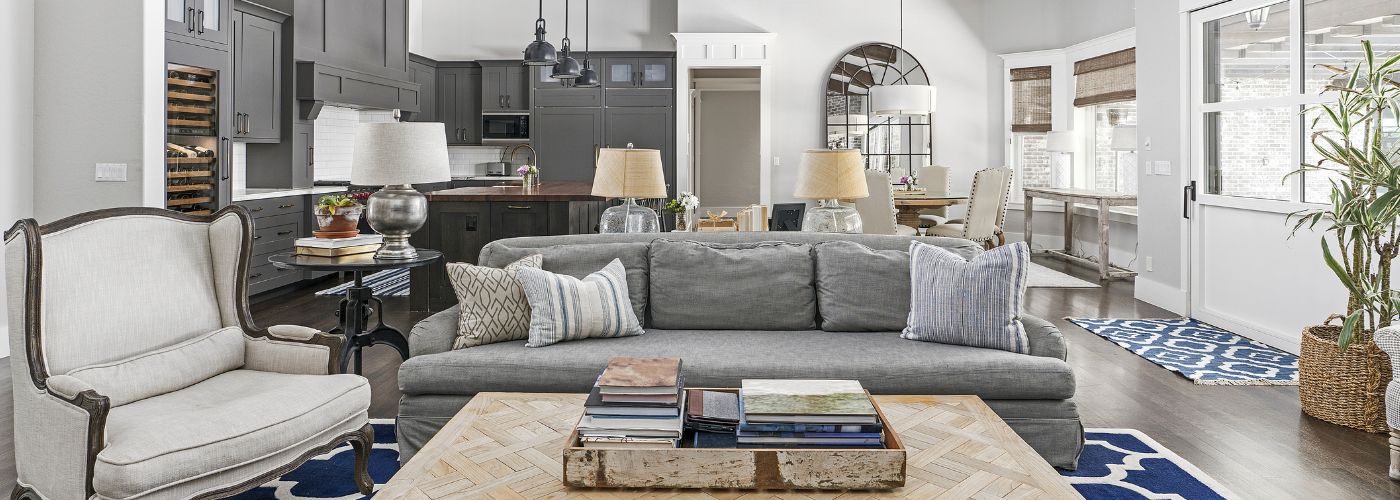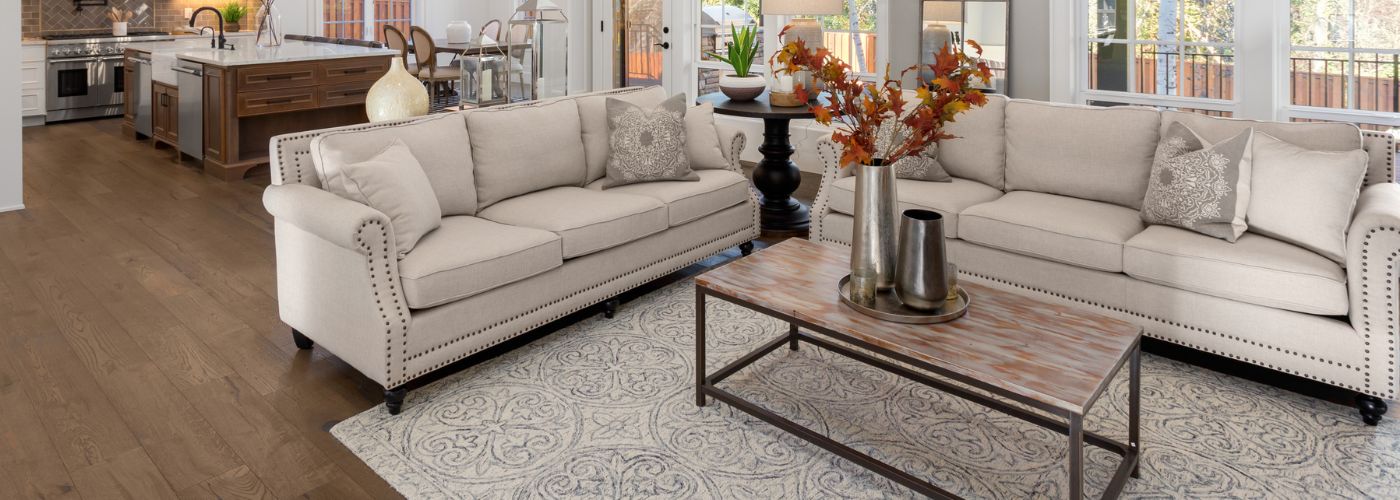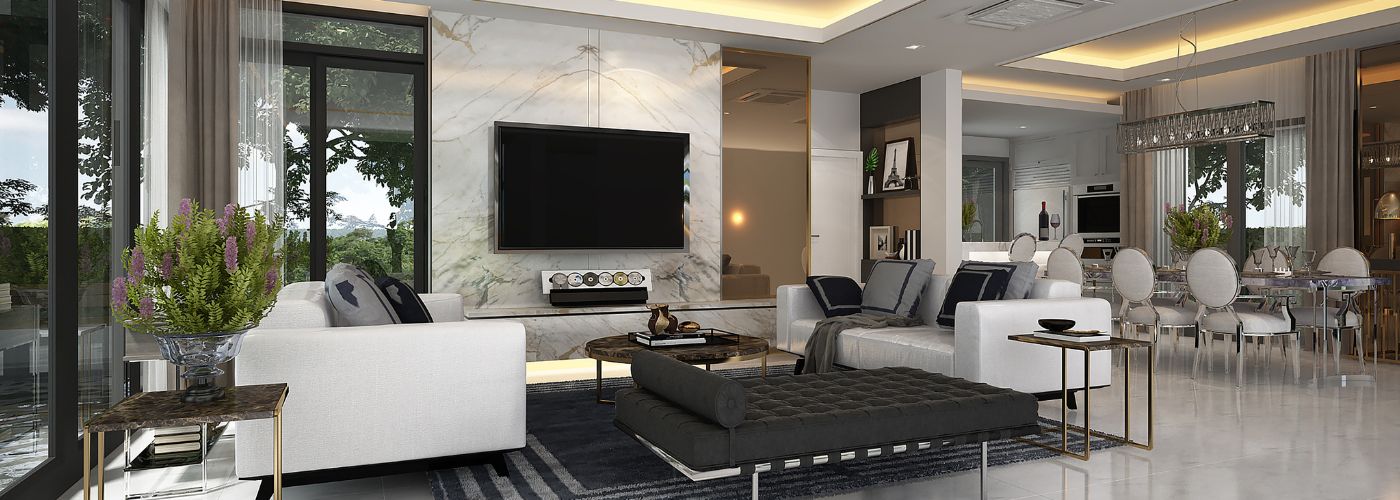Designing a combined living room and dining room space offers a unique opportunity to create a cohesive and functional area for multiple purposes. From maximizing space efficiency to enhancing aesthetics, numerous design ideas exist to consider when integrating these two essential home areas.
Whether you’re looking to create a seamless flow between the spaces, optimize seating arrangements, or infuse your style into the decor, this blog will explore various innovative design ideas to inspire your living room and dining room transformation.
Planning Your Living Room Dining Room Design
Consider functionality and aesthetics when designing your living room dining room to create a cohesive and inviting space. Start by assessing the room’s layout and dimensions to determine the best placement for furniture and dining essentials.
Consider the traffic flow and how people will move between the two areas, aiming for a seamless transition for easy movement and conversation. Select furniture pieces that serve dual purposes, such as a dining table that can also be used as a workspace or a sofa with built-in storage for stowing away dining linens or extra dinnerware.

When it comes to decor, choose a cohesive color scheme and style that ties the two areas together while still allowing each space to maintain its distinct identity. Incorporate elements like area rugs, lighting fixtures, and artwork to add visual interest and personality to the room.
Finally, remember to prioritize comfort and functionality by investing in quality furniture and accessories that enhance the overall usability of the space. With careful planning and attention to detail, you can create a living and dining room design that meets your needs and reflects your style.
Maximizing Living Room Dining Room Space
Maximizing the space in a combined living room and dining room requires thoughtful planning and strategic design choices. Start by selecting versatile and space-saving furniture pieces, such as extendable dining tables, folding chairs, or multifunctional storage ottomans. Opt for furniture with clean lines and a streamlined design to create an open and airy feel in the room. Utilize vertical space by installing floating shelves or wall-mounted cabinets to store dining essentials and display decorative items without taking up valuable floor space.
Consider incorporating built-in furniture or custom storage solutions to maximize storage capacity while minimizing clutter. When arranging furniture, aim for an efficient layout that allows for easy traffic flow and encourages conversation between seating areas.
Finally, maximize natural light by keeping window treatments minimal or opting for sheer curtains to let in as much sunlight as possible. By implementing these strategies, you can make the most of your living room dining room space and create a functional and stylish environment for everyday living and entertaining.
Essential Living Room Dining Room Lighting Fixtures
Selecting the right lighting fixtures for a combined living room and dining room space is crucial for creating ambiance, enhancing functionality, and defining different areas. Here are some essential lighting fixtures to consider:
Overhead Pendant Lights: Pendant lights suspended above the dining table can provide focused task lighting for mealtime while adding a decorative element to the space. Choose fixtures with adjustable heights or multiple pendants to accommodate different table sizes and configurations.
Chandeliers: A statement chandelier can serve as a focal point in the living room and dining room areas, providing general ambient lighting and adding visual interest. Opt for a chandelier with dimmable bulbs or adjustable brightness settings to create the desired atmosphere for various occasions.
Recessed Lighting: Recessed lights installed in the ceiling can offer subtle ambient lighting throughout the entire space, illuminating the room evenly without overpowering other decorative elements. Use dimmer switches to control the brightness and create different lighting levels for different activities.
Wall Sconces: Wall sconces mounted on either side of a fireplace or accent walls can provide additional ambient lighting and contribute to the overall ambiance. Choose fixtures with adjustable arms or directional shades to direct light where needed most.
Floor Lamps: Floor lamps placed strategically in the living room area can provide task lighting for reading or relaxing while adding height and visual interest to the space. Look for floor lamps with adjustable heads or shades to direct light where needed most.
Table Lamps: Table lamps placed on side tables or consoles can provide task lighting for activities like reading or working on a laptop while adding a warm, inviting glow to the room. Choose lamps with dimmable bulbs or adjustable brightness settings for added versatility.
Combining these essential lighting fixtures allows you to create a well-lit and inviting living and dining room space that meets your functional and aesthetic needs.
Wall Decor Ideas For Living Room Dining Room Designs
The possibilities for wall decor ideas for living room and dining room designs are endless. One approach is to create a cohesive gallery wall that spans both areas, featuring a mix of artwork, photographs, and decorative objects that complement the space’s overall style. Arrange the pieces in a balanced composition, mixing different sizes and shapes to add visual interest.
Another option is to use mirrors strategically placed on the walls to reflect light and create the illusion of more space, especially in smaller rooms. Choose decorative mirrors with interesting frames or shapes to enhance the room’s aesthetic appeal.

For a more modern look, consider incorporating geometric wall shelving units or modular storage systems that double as decorative elements while providing functional storage space for books, plants, or decorative objects. If you prefer a minimalist aesthetic, opt for large-scale artwork or statement murals that serve as focal points in the room.
Alternatively, you can add texture and warmth to the walls with woven wall hangings, tapestries, or fabric wall panels that bring a cozy, bohemian vibe. Whatever wall decor ideas you choose, consider the room’s scale, the existing furniture and decor, and your personal style preferences to create a harmonious and inviting living room dining room design.
Rugs and Carpets to Define Areas For Open Concepts
In open-concept living spaces, rugs and carpets are invaluable tools for defining and delineating different areas while maintaining a sense of cohesion and flow. By strategically placing rugs and carpets, you can create visual boundaries that help to designate specific zones for living, dining, and entertaining within the larger space.
Large area rugs can anchor seating arrangements in the living room area, providing a soft and comfortable foundation for furniture and adding warmth and texture. Similarly, placing a rug beneath the dining table helps to define the dining area and create a focal point for gatherings and meals.
Layering rugs of varying sizes and shapes is another effective technique for delineating separate areas within the open-concept layout. This allows you to create distinct zones for lounging, dining, and other activities.
Additionally, runners can be used to create pathways between different areas, guiding the flow of foot traffic while adding visual interest to the space. Whether you opt for traditional rugs, carpet tiles, or a combination of both, the key is to select pieces that complement the overall style and color scheme of the room while also serving the functional needs of each specific area.

With thoughtful placement and consideration of scale and proportion, rugs and carpets can transform an open concept space into a cohesive, inviting environment seamlessly integrating different living areas.
Accessorizing Tips to Tie Together Living Room Dining Room Design
Accessorizing plays a pivotal role in seamlessly tying together the design of a living room dining room space, infusing it with personality, functionality, and visual appeal. Select accessories that complement the room’s overall color scheme and style to achieve a cohesive look. Choose accent pieces, such as throw pillows, curtains, and decorative objects, that harmonize with the furnishings and architectural elements to create a sense of unity.
Consider incorporating a mix of textures, such as soft fabrics, natural materials, and metallic finishes, to add depth and visual interest to the space. Additionally, strategically placing statement pieces, like artwork, sculptures, or unique lighting fixtures, can serve as focal points that anchor each area while enhancing the overall aesthetic. Don’t overlook the importance of scale and proportion when accessorizing—opt for pieces that are appropriately sized for the room and complement the scale of the furniture.
Layering accessories, such as rugs, throws, and tabletop vignettes, can contribute to a well-coordinated look by adding dimension and warmth to the space. Lastly, infuse the room with personal touches and meaningful accents, such as family photos, heirlooms, or souvenirs, to imbue the space with your unique personality and create a welcoming atmosphere. By following these accessorizing tips, you can effectively tie together the design of the living room and dining room, resulting in a cohesive, stylish, and inviting space that reflects your taste and lifestyle.
Plants and Greenery for a Fresh and Cohesive Look
Incorporating plants and greenery into your living room dining room design is an excellent way to infuse the space with freshness, vitality, and a sense of harmony. Plants add visual interest and natural beauty to the room, help purify the air, and create a more inviting atmosphere.
When selecting plants for your space, consider lighting conditions, humidity levels, and maintenance requirements to ensure they thrive in their environment. Opt for various plant types, sizes, and shapes to create depth and dimension, strategically place them throughout the room to establish a cohesive and balanced look.
Tall floor plants can anchor corners and fill vertical space while trailing plants can cascade down shelves or hang from planters to add a dynamic element to the room. Grouping plants in clusters or arranging them in asymmetrical arrangements can create visual interest and draw the eye, reinforcing the connection between the living and dining room areas.
Also, choose pots and planters that complement your decor style and color palette, whether sleek and modern or rustic and eclectic. By incorporating plants and greenery into your living room dining room design, you can create a fresh, vibrant, and cohesive space that enhances your overall well-being and enjoyment of the room.
Ultimately, the key is to balance style and functionality, creating a space that reflects your unique personality and meets your practical needs for everyday living and entertaining. With careful planning and attention to detail, you can achieve a living room dining room design that is inviting and inspiring for years to come.

How to Love Your Home Again
Sometimes we can feel uninspired and tiresome with the home we once loved so dearly.
Jan
Affordable Ways to Glamorize Your Home
There are many affordable ways to glamorize your home; elka Interiors & Construction is here
Jan
How to Stage Your Bathroom to Add Appeal
Home staging is a great way to incorporate an added sense of luxury and increase
Jan